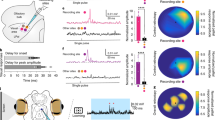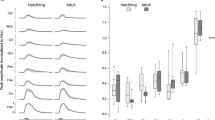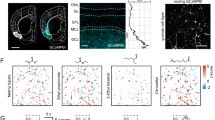Abstract
Star-nosed moles have 11 mechanosensory appendages surrounding each nostril, and primary afferents from a single appendage—the tactile fovea—are greatly over-represented in somatosensory cortex. It was found that the foveal appendage led development in the periphery, had the greatest innervated surface area in embryos, and developed mature nerve terminals and epidermal sensory organs first; also, in developing cortex, markers for metabolic activity (cytochrome oxidase) appeared first in the fovea representation. This developmental sequence may provide the fovea with an advantage in a competition for cortical space, and account for the much larger areas of cortex devoted to foveal afferents.
This is a preview of subscription content, access via your institution
Access options
Subscribe to this journal
Receive 12 print issues and online access
$209.00 per year
only $17.42 per issue
Buy this article
- Purchase on Springer Link
- Instant access to full article PDF
Prices may be subject to local taxes which are calculated during checkout



Similar content being viewed by others
References
Lee, K. J. & Woolsey, T. A. Brain Res. 99, 349–353 (1975).
Welker, E. & Van der Loos, H. J. Neurosci. 6, 3355–3373 (1986).
Azzopardi, P. & Cowey, A. Nature 361, 719–721 (1993).
Catania, K. C. Nature 375, 453–454 (1995).
Catania, K. C. & Kaas, J. H. J. Comp. Neurol. 387, 215–233 (1997).
Wong-Riley, M. T. Trends Neurosci. 12, 94–101 (1989).
Stryker, M. P. & Harris, W. J. Neurosci. 6, 2117–2133 (1986).
Hubel, D. H., Wiesel, T. N. & Levay, S. Phil. Trans. R. Soc. Lond. B Biol. Sci. 278, 377–409 (1977).
Schlaggar, B. L., Fox, K. & O'Leary, D. D. M. Nature 364, 623–626 (1993).
Jenkins, W. M., Merzenich, M. M., Ochs, M. T., Allard, T. & Guic-Robles, E. J. Neurophysiol. 63, 82–104 (1990).
Kaas, J. H. Annu. Rev. Neurosci. 14, 137–167 (1991).
Xerri, C., Merzenich, M. M., Jenkins, W. & Santucci, S. Cereb. Cortex 9, 264–276 (1999).
Purves, D., Riddle, D. R., White, L. E. & Gutierrez-Ospina, G. Curr. Opin. Neurobiol. 4, 120–123 (1994).
Miyaka, T., Cameron, A. M. & Hall, B. K. J. Craniofac. Genet. Dev. Biol. 16, 1–31 (1996).
Rapaport, D. H. & Stone, J. Neuroscience 11, 289–301 (1984).
Acknowledgements
Research was supported by NIH grant MH 58909 to K.C. Catania and approved by the Vanderbilt University Animal Care Committee. Moles were collected under scientific collecting permit COL 00087 and juveniles were from rare captive raised litters.
Author information
Authors and Affiliations
Corresponding author
Supplementary information
Rights and permissions
About this article
Cite this article
Catania, K. Early development of a somatosensory fovea: a head start in the cortical space race?. Nat Neurosci 4, 353–354 (2001). https://doi.org/10.1038/85992
Received:
Accepted:
Issue Date:
DOI: https://doi.org/10.1038/85992
This article is cited by
-
A star-nose-like tactile-olfactory bionic sensing array for robust object recognition in non-visual environments
Nature Communications (2022)
-
Interpreting fMRI data: maps, modules and dimensions
Nature Reviews Neuroscience (2008)
-
Postnatal growth and column spacing in cat primary visual cortex
Experimental Brain Research (2003)
-
Mole nose its own mind
Nature (2001)
-
A head start in the cortical space race
Nature Reviews Neuroscience (2001)



